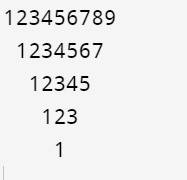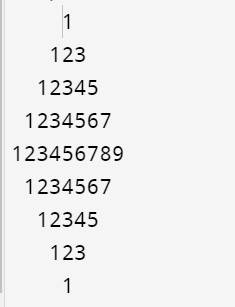Number Pattern Programs in C
Pattern programs in C are a type of problem that uses nested loops to produce different patterns of numbers, stars (*), or other characters. In this blog, we will dive deeper, specifically into number pattern programs in C programming language!
Number pattern programs in C display a sequence of numbers in certain patterns. These programs are often used as a practical exercise for learning loop control structures in C (i.e., for loops, while loops, and do-while loops). The patterns could be anything from a simple pyramid shape to more complex combinations and sequences of numbers.

Basic Approach to Solve a Number Pattern Program Using an Example
Step 1: Understand the Pattern
- Visualize the Pattern: Observe the pattern to understand its structure.
- Identify the Number of Rows and Columns: Determine the number of rows and columns in the pattern.
- Analyze the Sequence: Understand how the numbers are arranged in each row and column.
Example Pattern
5 4 3 2 1 2 3 4 5
4 3 2 1 2 3 4
3 2 1 2 3
2 1 2
1
Step 2: Initialize the Program
#include <stdio.h>
int main() { // Code goes here}
Step 3: Determine and Set the Number of Rows
Set the Number of Rows: Determine how many rows the pattern will have.
int n = 5; // The pattern has 5 rows
Step 4: Construct an Outer Loop for Rows
Create the Outer Loop: Set up an outer loop to iterate through the rows.
for (int i = n; i >= 1; i--) { // Inner loops will go here}
Step 5: Construct Inner Loops for Columns
Create Inner Loops for Columns: Utilize inner loops to manage the columns and print the numbers.
// First half: Descending numbersfor (int j = i; j >= 1; j--) { printf("%d ", j);}
// Second half: Ascending numbersfor (int j = 2; j <= i; j++) { printf("%d ", j);}
Step 6: Combine and Execute the Code
Combine All Code Segments: Combine all parts and run the program to print the pattern.
#include <stdio.h>
int main() { int n = 5; // Number of rows
for (int i = n; i >= 1; i--) { // First half: Descending numbers for (int j = i; j >= 1; j--) { printf("%d ", j); }
// Second half: Ascending numbers for (int j = 2; j <= i; j++) { printf("%d ", j); }
printf("\n"); }
return 0;}
Following the above steps, you can systematically approach and solve any number pattern program in C Programming Language.
Let's check a video on the same
Source: Example Program
Best-suited C / C++ courses for you
Learn C / C++ with these high-rated online courses
Top Number Pattern Programs in C
- Right-Angle Triangle Pattern
- Inverted Right-Angle Triangle Pattern
- Pyramid Number Pattern
- Inverted Pyramid Number Pattern
- Diamond Number Pattern
Let’s understand each of these one by one in detail
Right-Angle Triangle Pattern: A simple pattern where each row contains increasing consecutive numbers.
Code
#include <stdio.h>
int main() { for (int i = 1; i <= 5; i++) { for (int j = 1; j <= i; j++) { printf("%d ", j); } printf("\n"); }
return 0;}
Inverted Right-Angle Triangle Pattern: Similar to the right-angle triangle pattern but inverted.
#include <stdio.h>
int main() { for (int i = 5; i >= 1; i--) { for (int j = 1; j <= i; j++) { printf("%d ", j); } printf("\n"); }
return 0;}
Pyramid Number Pattern: A pattern of numbers arranged in the form of a pyramid.
#include <stdio.h>
int main() { int n = 5;
for (int i = 0; i < n; i++) { // Print spaces for (int j = 0; j < n - i; j++) { printf(" "); }
// Print ascending numbers for (int k = 0; k <= i; k++) { printf("%d", k + 1); }
// Print descending numbers for (int l = i - 1; l >= 0; l--) { printf("%d", l + 1); }
// Move to the next line printf("\n"); }
return 0;}
Inverted Pyramid Number Pattern: An inverted version of the pyramid number pattern.
#include <stdio.h>
int main() { int n = 5;
for (int i = n; i >= 1; i--) { // Print leading spaces for (int j = n; j > i; j--) { printf(" "); }
// Print the number pattern for (int k = 1; k < (i * 2); k++) { printf("%d", k); }
// Move to the next line printf("\n"); }
return 0;}
Diamond Number Pattern: A pattern where numbers are arranged in a diamond shape.
#include <stdio.h>
int main() { int n = 5;
// Upper half of the diamond for (int i = 1; i <= n; i++) { for (int j = i; j < n; j++) { printf(" "); } for (int k = 1; k < (i * 2); k++) { printf("%d", k); } printf("\n"); }
// Lower half of the diamond for (int i = n - 1; i >= 1; i--) { for (int j = n; j > i; j--) { printf(" "); } for (int k = 1; k < (i * 2); k++) { printf("%d", k); } printf("\n"); }
return 0;}



Thus, number pattern programs in C are an essential part of foundational programming learning and practice. They not only help in understanding the use and manipulation of loops and control statements, but also enhance logical thinking and problem-solving skills.
FAQs
What Are Number Pattern Programs in C?
Number pattern programs are exercises in C programming that involve displaying sequences or arrangements of numbers in specific patterns. These patterns can range from simple sequences to more complex designs like pyramids, diamonds, or other geometric shapes. They serve as excellent practice for understanding loops, conditional statements, and the overall syntax of the C programming language.
Why Are Number Pattern Programs Important to Learn?
Learning to write number pattern programs is crucial for several reasons:
- Fundamental Concepts: They reinforce understanding of basic programming constructs like loops (for, while, do-while) and conditionals (if, else).
- Problem-Solving Skills: Crafting these patterns requires logical thinking and problem-solving skills, essential for tackling more complex programming challenges.
- Practice and Familiarity: They provide practical experience with the C language syntax and programming logic, building a strong foundation for future development tasks.
How Do Loops Help in Generating Number Patterns?
Loops are the backbone of number pattern programs. They allow the repeated execution of a code block, which is necessary for generating each line of a pattern and the elements within those lines. Depending on the pattern's complexity, nested loops (a loop inside another loop) may be used to control the rows and columns of the pattern.
What Are Some Common Number Patterns in C Programming Practice?
Common number patterns include:
- Straight Line: Sequential numbers in a single line.
- Pyramid: Numbers arranged in a pyramid shape, often increasing with each row.
- Inverted Pyramid: Similar to a pyramid but inverted, with the widest row at the top.
- Diamond: A combination of a pyramid and an inverted pyramid to form a diamond shape.
- Floyd's Triangle: A pyramid of numbers where each row contains consecutive numbers starting from 1.
How Does One Approach Solving Number Pattern Problems?
To solve number pattern problems, one should:
- Analyze the Pattern: Break down the pattern into smaller parts or steps. Identify the repetition in rows and columns.
- Determine the Logic: Figure out the relationship between loop counters and the numbers to be printed. This might involve arithmetic or conditional operations.
- Implement with Loops: Use loops to iterate over rows and columns, applying the logic determined to print the correct numbers.
- Use Nested Loops: For complex patterns, nested loops (a loop within another loop) are often required to manage the printing of rows and columns separately.







